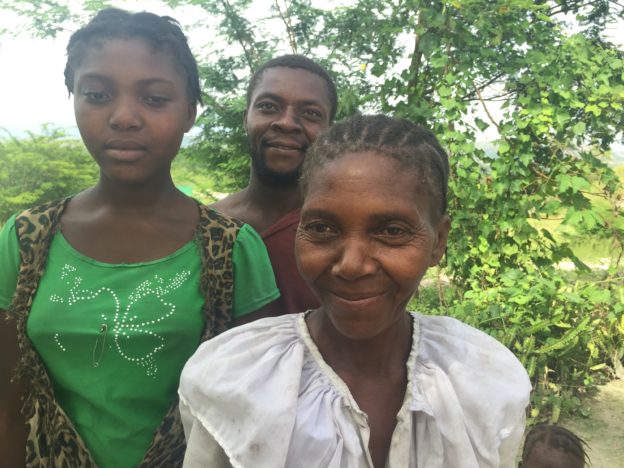When Isemène joined the CLM program, she was unusually poor even by the standards of a program designed for the very poorest rural families in Haiti. Her husband had recently died in Lachapèl, where they were living at the time. Isemène sold everything that the family had to pay for the funeral.
With nowhere to live and nothing to live on, she wandered to Sodo with her seven children. Sodo is home to one of the largest annual parish festivals in Haiti, and it attracts a lot of beggars. Isemène says, “M t ap mache tcheke lavi.” That’s a little hard to translate. It’s like saying she decided to take to the street to see whether she could find a way to live. While at the festival, she met a local man, a stranger, who heard her story and was willing to let her boys set up a shack for the family on a corner of his land. That’s where we found her when we went through the area.
Isemène chose goats and a pig as her two enterprises. And though her livestock never really flourished, she was able to add a small cow by the end of her time in the program. She also established a steady source of income. Using a thousand gourds that she saved during the six months of her weekly 300-gourd stipend, she started buying scrap wood and turning it into charcoal, which she would sell by the sack in Mirebalais. She also started sending her younger children to school, something she had been unable to do since her husband’s death.
Perhaps even more importantly, she bought a small piece of land in an empty area along the road to Sodo. She completed the purchase at a critical time, just as her youngest child, a boy just hitting his teens, suddenly died. When our team interviewed her, she explained that the most important thing about owning the land was that it gave her someplace to bury her son.
Four years later, her life has changed in some ways, but remained the same in others. Her livestock is gone. She had grown impatient with its slow growth, so she made the risky decision to sell it all and use the proceeds of the sale to buy a cow much larger than the one she sold. The new one grew well, and soon it was pregnant. But the areas along Sodo’s main roads see a lot of theft. The unpaved, mountainous route from Sodo to Titayen is a favorite passage for smugglers and thieves into Port au Prince. One day, Isemène’s cow disappeared. She finally found its butchered remains – including the unborn calf – in the bushes. Though she reported the theft to a justice of the peace, there was nothing he could do to make up her loss.
Her two older boys eventually moved out of her house, building their own homes on their mother’s land. One lives with his wife and two children, supporting them by farming as a sharecropper. The other learned his mother’s business, and supports the child he had with a woman from whom he is separated by selling charcoal. Isemène and the boys have planted trees in the yard, and it is beginning to feel like a lakou, the sort of the collection of homes that is the basis for Haitian rural life. Isemène glows when she speaks of how happy it makes her to know that she and her children have a place that is their own.
She still supports her younger children with the charcoal business. She’s never been able to increase it, but she makes sure it doesn’t shrink. After four years, she still depends on the same one thousand gourds of capital. She makes 1000 to 1500 gourds of profit each time to sells a load in Mirebalais. She knows she could make more if she took the time to sit in the market and sell it in small bags, rather than by sacks, but she worries that the women who buy her sacks so that they can divide them into retail portions would resent her if she took over both roles. She also believes she could grow the business if she was able to get the kind of loan she heard about before graduation. CLM members who live in areas served by Fonkoze’s microcredit operations receive training in the use of credit. But she wasn’t able to find women interested in forming a five-person solidarity group with her.
And though her income is enough to keep the family afloat, her inability to make it grow has become a problem. Tuition prices at local schools have gone up considerably over the last couple of years, and this year she could not afford to send her children. She can’t yet imagine how she might send them next year, either. Her one hope in this regard is for her teenage boy. He saved up enough money from doing chores for her and for neighbors as well that he was able to buy a small pig. If it survives, it could allow him to pay his own way to school next year.
